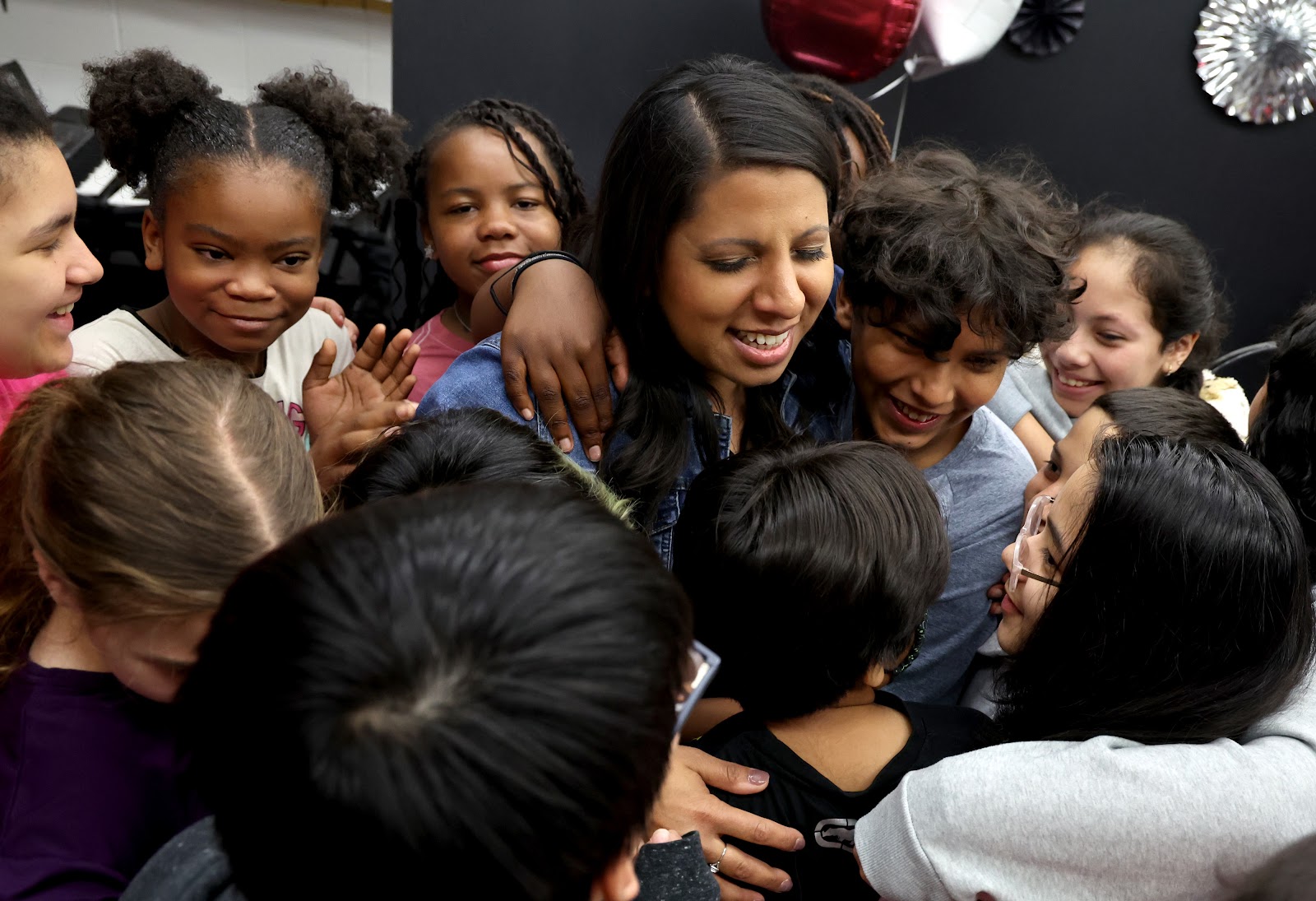Visitors and passersby can see a big bulletin board with Indigenous people at the center and a social justice vocabulary wall in the back of the room, where kids learn terms such as cultural appropriation and ethnocentric immigrant refugee. Mahmood guides her students in writing historical fiction and facilitates frequent conversations about why people of color and marginalized communities have historically been relegated to the margins of textbooks or left out altogether.
Mahmood has informed students about Manilamen Larry Itliong and Philip Vera Cruz — Filipino American labor organizers who were part of the 1965-1966 strike and boycott against California grape growers — and astronauts, including Kalpana Chawla and Sunita Williams.
As leader of the school’s social justice club, Mahmood also thinks up projects for students to engage their civic muscles monthly, such as conducting a drive for hygiene items for the refugee population in the Chicagoland area.
Mahmood stays ready with cultural resources, adamant that the next generation will see themselves and their identities in the school curriculum. That’s a big part of the reason she became a teacher.
With a mother who is a Russian Jew, a dad who is an Indian Hindu, stepparents who are German-Italian Catholics and a husband who is a Pakistani Muslim, Mahmood said she grew up absent from the curriculum. That’s why it was so important to be a part of the TEAACH Act legislation and its implementation.
“When you’re absent from the curriculum, you learn a lot of unintentional lessons from well-intentioned people,” Mahmood said. “I learned lessons about my identity that were unintentional that caused me a lot of trauma. Then I found multicultural education. I became a teacher, because I was still searching for that belonging in school.”
Mahmood has made it a point to be a teacher who normalizes cultures, languages, foods, stories and histories of all backgrounds. “Our culture is one of the greatest assets we bring to our community,” she said. “It’s not a hindrance; it defines who we are and makes our wonderful world complex and interesting. We all need to lift each other up in spaces so people can feel a sense of belonging.”
Grace Pai, executive director of Asian Americans Advancing Justice Chicago, or AAAJ-Chicago, was instrumental in getting the TEAACH Act passed in 2021. Efforts were launched at the same time the nation was shutting down because of the pandemic. The goal is to combat discrimination and harmful stereotypes that lead to violence.
So far, AAAJ-Chicago has trained more than 2,200 educators across the state on how to approach and teach Asian American history, Pai said. It starts with an introductory two-hour professional development workshop and continues with resources that include a teaching database that offers book recommendations, videos, lesson plans and articles that tie topics in Asian American history to state learning standards.
Mahmood has helped with the professional development around TEAACH through her education consulting practice. Pai envisions more teacher training and engagement with Asian American curricula, as well as asking constituents to ask school administrations for proof the history is being taught. And if it’s not, to advocate for it.
According to Pai, AAAJ-Chicago is one of a handful of organizations seeking more funds from the Illinois legislature to expand an existing, yearlong professional development series on inclusive history for educators — one that supports all-inclusive history requirements.
Jeremy Bautista, a Filipino American IT professional at Westmont High School, connected with the Very Asian Foundation in September to help bring teaching resources and AAAJ-Chicago’s professional development workshop to his school. Bautista brought together teachers from Westmont’s English, social studies and science departments to incorporate Asian American curricula into their lesson plans. Bautista, who has a master’s degree in teaching, sees the TEAACH Act as one facet of a bigger picture that has been a long time coming.
“To be aware of a part of American history that might inform your conversations in class … to share a different perspective, this is what the TEAACH Act is for,” he said. “It’s good to talk about diverse backgrounds. It’s not this trivial thing.”
Bautista co-sponsors the student group CAPAOW!, the Club of Asian and Pacific Americans of Westmont at Westmont High School.
“Kids see the value of having teachers educated — students want their teachers to be more informed and understanding of their culture,” Bautista said. “You need people like Dr. Mahmood, and a place like Westmont that are embracing that so kids can grow up understanding that they’re part of this process, they’re part of this society and this world and it’s OK to be you.”
Bautista has worked in his hometown school district for over 25 years and said when he learned about the TEAACH Act, he was excited.
“The benefit of the resources is for everybody,” he said. “Asian American students, sure, but they get to share with their friends … and it’s inspired other groups to do the same thing.”
He said for European refugees, seeing CAPAOW! and the Asian American curriculum in the lessons shows them they also have a voice and a safe space to share their culture.
“It means a lot to the kids to normalize those aspects of their identity which are often marginalized or completely invisible,” Mahmood said.
Mahmood went to school in Downers Grove and remembers learning about the Holocaust and a little about Hinduism in sixth grade.
“If you don’t talk about Asian Americans, then you learn that they’re not part of history,” she said. “Mexicans are not part of history … you learn unintentional lessons through what you read; you open a textbook and they’re not there. That means that they’re not important. You don’t realize it when you’re little, but 20 years later, like me, I tell my students I learned all these negative things about my culture. I’m discovering all these things about my culture now, and I wish I would have learned them as a kid so I was less embarrassed and more proud. I don’t want you to take 20 years to learn it.”
Mahmood joined Indian Prairie School District 204 in 2005 and has spent the last nine years at Georgetown Elementary School. She has led diversity and equity teams across the district, worked to encourage interfaith discussions and written curriculum for her district and beyond.
With her teacher of the year state honor comes a yearlong paid sabbatical to bring her culturally responsive teaching practices to educators and schools around the state and to share her approach to teaching on the platform concept of “belonging.”
“We need to create spaces where not only students feel that they belong, but staff (too); and part of that is letting people show up as their authentic self,” Mahmood said. “Part of that is understanding people’s histories, contributions and culture and all of those pieces that make them uniquely themselves.”
Her culturally responsive teaching is constantly observing students to see what their needs and fears are. Mahmood is taking the next school year to travel around the state; she wants to connect with people, hear what they need and help with those needs.
Mahmood said by viewing students’ cultures as assets and tools that can be leveraged in the classroom, instead of obstacles to overcome, the educational system can change for the better.
“You’re seeing the knowledge they bring, the cultural assets they have. And you’re responding to it by changing the way you teach, what you teach, enhancing it in a way that everything they bring to school becomes useful to them,” she said. “We can do the same thing with teachers. There’s so much diversity in our community and every part of that diversity belongs in education.”


